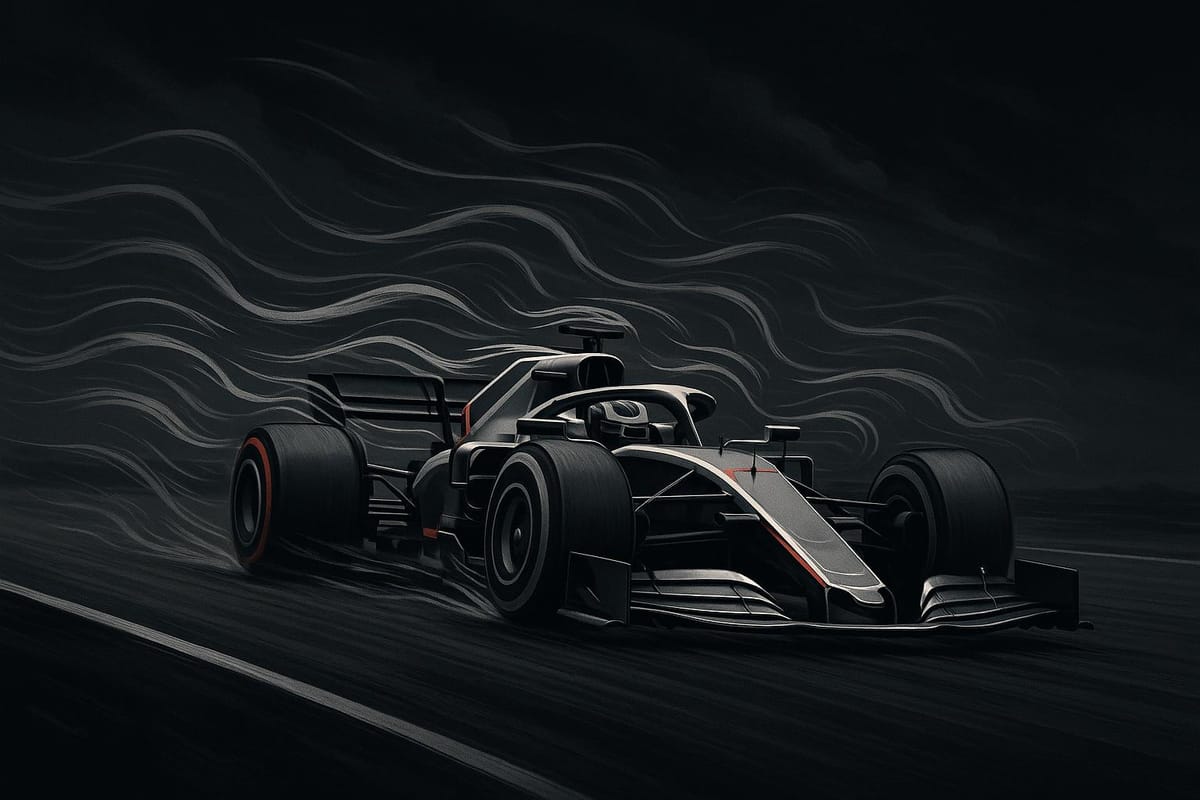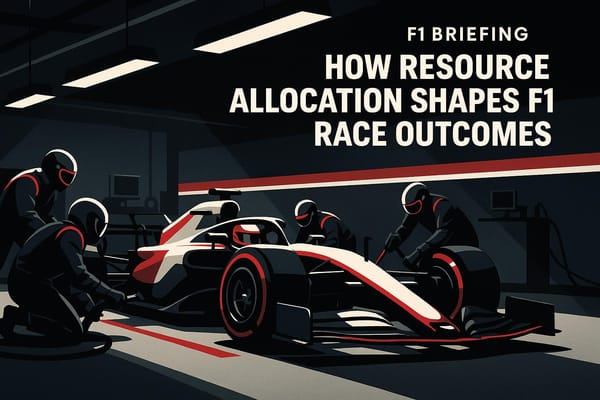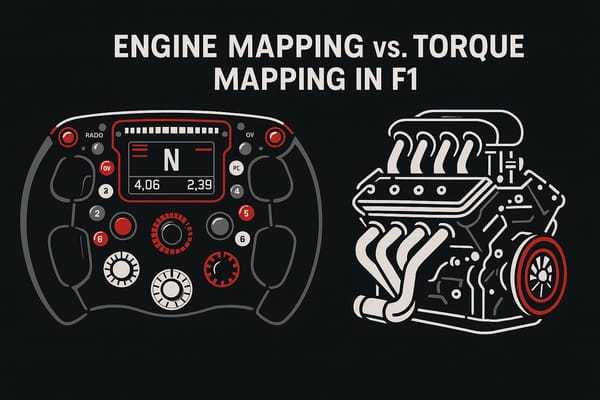How Wind Affects F1 Car Stability
Explore how wind impacts F1 car stability, influencing strategies and driver performance on the track.

It can destabilize cars, disrupt strategies, and test drivers' skills. Here's what you need to know:
- Crosswinds: Push cars sideways, making it hard to maintain control, especially in corners.
- Headwinds: Increase drag but improve cornering grip due to higher downforce.
- Tailwinds: Reduce drag for higher speeds but lower grip in corners.
- Sudden Gusts: Unpredictable bursts that destabilize cars instantly.
Key Areas Affected:
- Front and Rear Wings: Crucial for downforce; sensitive to wind changes.
- Floor and Diffuser: Generate most of the car's downforce; disrupted by wind.
- Tires: Uneven wind causes irregular wear and impacts grip.
How Teams Manage Wind:
- Adjust wing angles and aerodynamic settings.
- Use real-time wind data and sensors.
- Train drivers to adapt braking and cornering techniques.
Wind isn't just a challenge; it's an opportunity for teams to fine-tune their strategies and gain an edge. Read on to see how F1 teams and drivers master this unpredictable force.
How Does Yaw Angle Affect F1 Aerodynamics? - Talking Tech Trends
Different Types of Wind and Their Effects on F1 Cars
In Formula 1, the way wind interacts with a car's aerodynamics can make or break its performance on the track. Each type of wind brings unique challenges, and teams must account for these to keep their cars stable and competitive. Let’s dive into how crosswinds, headwinds, tailwinds, and sudden gusts affect F1 cars.
Crosswinds: A Driver’s Nightmare
Crosswinds are among the most challenging conditions for F1 drivers to handle. When wind blows from the side, it disrupts the car's balance, causing it to yaw or shift sideways. This lateral push makes it incredibly tough for drivers to maintain control, especially during high-speed corners. Sudden crosswinds can throw off the car's aerodynamic setup, forcing drivers to make quick steering corrections. Not only does this slow lap times, but it also increases the risk of losing control or crashing.
Headwinds and Tailwinds: Opposite Effects
Headwinds and tailwinds bring their own set of aerodynamic hurdles. A headwind increases air resistance, which means the engine has to work harder to maintain high speeds. However, the upside is that more airflow increases downforce, giving the car better grip in corners - though at the cost of reduced top speed and potentially higher fuel consumption. On the flip side, a tailwind decreases air resistance, allowing for higher straight-line speeds. But with less downforce, the car loses grip in corners, making it harder to maintain stability. Teams often tweak wing angles and other aerodynamic settings to find the best balance, depending on the expected wind conditions.
Wind Gusts: The Unpredictable Factor
Sudden wind gusts are the wildcard in Formula 1. Unlike steady winds, these unpredictable bursts can disrupt airflow around the car in an instant, throwing off its aerodynamic balance. Drivers have little time to react, and even the most finely tuned setups can feel unstable in these moments. To combat this, teams rely on live wind data and advanced weather forecasting tools. These insights help them make real-time adjustments to setups and provide drivers with guidance to navigate rapidly changing conditions.
F1 Car Parts Most Affected by Wind
Wind doesn’t affect all parts of an F1 car equally. Some components are particularly sensitive, and when wind disrupts their performance, it can throw off the car’s balance and handling. This makes racing on windy tracks a tough challenge for teams and drivers.
Front and Rear Wings
The front and rear wings are precision-engineered carbon fiber components, designed to manage airflow and generate downforce. However, even slight wind changes can impact their performance.
The front wing is especially critical, as it produces about one-third of the car's total downforce. It’s the first aerodynamic element to interact with the air, directing it toward other parts of the car. As Harshal Parshionikar puts it:
"The front wing, unlike the rear, does not just provide downforce. As it is the aerodynamic device that precedes the entire car, it is also responsible for directing airflow back towards the rest of the car." – Harshal Parshionikar
Crosswinds can reduce the front wing’s effectiveness by altering its angle of attack. This disruption can stall airflow, causing a sudden loss of downforce.
The rear wing, on the other hand, has gained more importance in modern F1 designs. In the 1990s, the front wing contributed 40–50% of the car’s downforce, while the rear wing accounted for 50–60%. Today, the balance has shifted, with the rear wing now responsible for over 70% of the car’s downforce. This makes it highly sensitive to wind, as any disruption can destabilize the car.
Floor and Diffuser
The floor and diffuser system is one of the most important aerodynamic features in modern F1 cars, generating up to 60% of the car’s total downforce. These components use ground effect principles to create a low-pressure zone under the car, effectively sucking it closer to the track.
Wind can interfere with this system by disrupting airflow vortices, instantly reducing downforce. As Racecar Engineering explains:
"The key role of the diffuser on a modern racecar is to accelerate the flow of air under the car, creating an area of low pressure, thus increasing downforce." – Racecar Engineering
Ride height is another factor that affects the floor and diffuser’s performance. When wind causes the car to oscillate vertically, even small changes in ride height can stall airflow, leading to unpredictable handling.
Car Body and Aerodynamic Surfaces
The entire body of an F1 car is designed to manage airflow efficiently. Every curve and angle plays a role in maintaining stability, but wind can disrupt these carefully optimized surfaces. Crosswinds are particularly troublesome, as they can cause the car to yaw, making it unstable.
At high speeds - 200 mph or more - even moderate wind resistance can have a noticeable effect. The side surfaces, such as the sidepods and areas around the cockpit, act like sails in crosswinds. Teams sometimes tweak these areas by adding small aerodynamic elements or reshaping the car’s body to handle variable wind conditions better. However, these adjustments can’t fully eliminate the challenges posed by strong gusts.
Tracks like Silverstone in the UK and the Jeddah Corniche Circuit in Saudi Arabia are notorious for their unpredictable winds. Drivers often struggle to maintain control, with sudden gusts forcing them to adjust braking points and cornering speeds. These conditions make consistency on windy tracks a constant battle.
Problems Teams Face Because of Wind
Wind presents a host of challenges in Formula 1, often influencing the fine line between victory and defeat. Teams must constantly adapt to these conditions while striving to maintain competitive lap times and ensuring drivers' safety on the track.
Loss of Control in Fast Corners
High-speed corners become particularly hazardous when strong winds disrupt the car's aerodynamic balance. Sudden gusts can destabilize the car in an instant, especially in fast, sweeping turns where drivers are already pushing the limits of grip and downforce.
Crosswinds are especially tricky on circuits with high-speed sections. A sudden gust can cause the rear of the car to step out or make the front lose grip unexpectedly. Since drivers cannot predict when these gusts will strike, they often leave a safety margin in fast corners, which directly impacts their lap times.
F1 Technical Writer Jakub Winiewski highlights the danger of these sudden wind changes:
"The most dangerous are sudden gusts, because then the driver suddenly loses stability and it is much more difficult for him to react."
While teams keep a close eye on wind patterns and tweak car setups to minimize aerodynamic disruptions, they can't eliminate the risk entirely. Wind direction changes during a race can turn previously stable corners into high-risk zones, catching drivers off guard. Beyond handling issues, these wind shifts also affect tire performance, adding another layer of complexity.
Uneven Tire Wear and Grip
Wind doesn’t just mess with aerodynamics - it also impacts tire performance by creating uneven loading. When crosswinds push the car sideways, one side of the car works harder than the other, leading to irregular tire wear and unpredictable grip levels.
Gusts can disrupt even the most meticulously planned tire strategies. Wind-induced temperature variations across the track further complicate matters. For instance, hotter sections of the track reduce grip, while cooler areas can make tires less effective. This results in drivers experiencing excellent traction in one part of the circuit but struggling just a few corners later.
A great example of this was the 2020 Turkish Grand Prix. The newly resurfaced track already had minimal grip, and unpredictable wind conditions made tire management a nightmare. Teams found their usual strategies ineffective, whether in dry or wet conditions.
Driver Adjustment and Confidence Issues
Wind-induced aerodynamic disruptions don’t just affect the car - they also place a significant mental strain on drivers. Changing wind conditions force drivers to constantly adjust their braking points, cornering speeds, and racing lines, all while navigating the track at incredible speeds.
Ferrari’s experience during pre-season testing in 2024 illustrates how wind sensitivity can impact driver confidence. Carlos Sainz noted that the Ferrari SF-24 was less affected by wind compared to the previous year’s car. The gusty conditions at the Sakhir circuit provided a real-world test of this improvement.
Ferrari Technical Director Enrique Cardile explained the connection between wind sensitivity and driver performance:
"So the more you lose in yaw, the more you'll suffer from wind. Related to this is the driver confidence and how peaky the performance is. With the right condition, you have more performance but a certain type of corner with the wind, the driver doesn't know when the gust will happen."
This constant need for adjustment increases the mental workload, making it harder for drivers to deliver consistent performance. Effective communication between drivers and engineers becomes essential in such conditions. Real-time updates on grip levels and track conditions are critical for making informed strategic decisions. Without this feedback loop, teams risk making setup changes that may worsen the problem.
These wind-related challenges push teams to refine their aerodynamic setups and enhance driver training, as explored in the following sections.
How Teams Fight Wind Problems
In Formula 1, teams tackle wind-related challenges with a mix of cutting-edge technology and strategic adjustments. These efforts aim to reduce the unpredictable effects of wind while keeping performance at its peak on the track.
Changing Aerodynamic Settings
One of the first steps teams take is tweaking their cars' aerodynamic components to suit the expected wind conditions at each circuit. These changes help strike the right balance between downforce, drag, and stability in shifting winds.
Wing angle adjustments are a common modification. Engineers fine-tune the angles of the front and rear wings to optimize airflow. When strong crosswinds are forecasted, teams often reduce wing angles slightly, making the car less sensitive to side forces, even if it means sacrificing some downforce.
The car's floor also plays a crucial role. Since about 50% of a Formula 1 car's downforce comes from the aerodynamics underneath it - particularly the floor and diffuser - teams pay close attention to this area. Minor tweaks, like modifying the floor edges, can stabilize airflow and reduce disruptions caused by wind.
To refine these aerodynamic settings, engineers rely on aero rakes - specialized sensors that measure airflow during practice sessions. This data helps teams evaluate how well their adjustments work under real-world conditions.
"Each track is different so the setup of each car must be a balance of speed down the straight and grip on the corners." - Guy Snelling, Technical Director
These aerodynamic strategies are closely monitored using advanced sensors, allowing for real-time fine-tuning.
Wind Sensors and Live Data Systems
Modern Formula 1 cars are equipped with an extensive network of sensors that collect real-time data, helping teams adapt to changing wind conditions during a race weekend.
Each car is fitted with over 250 sensors, generating approximately 30 megabytes of data per lap and accumulating over 1 terabyte of data across a race weekend. This information gives teams a detailed picture of wind patterns and their impact on performance.
Mercedes, for example, has described the wide range of data they collect:
"We generate data from a variety of sources. Primarily it's from sensors on the car itself, and those can be anything from measurements of physical quantities, like temperatures, pressures, torques, and speeds, right through to things like the operation of the system like the internal state of all sorts of things on the car, like the gearbox." - Evan Short, Team Leader of Trackside Electronics Systems at Mercedes F1
These sensors fall into three categories: control, instrumentation, and monitoring. Mercedes' Lead Electronics Development Engineer Christine Steven explains:
"There are over 250 sensors on the car during an average race weekend, and these can be divided into three main categories: control, instrumentation, and monitoring. All of this delivers pressure temperature, inertial, and displacement data."
This data allows teams to make quick, informed decisions. For example, during the 2019 British Grand Prix, Mercedes used real-time data to analyze tire wear, fuel consumption, and competitor positions. This helped them time Lewis Hamilton's pit stop perfectly during a safety car period, contributing to his victory.
These systems not only inform aerodynamic updates but also support strategic decisions and driver guidance.
Driver Training and Technique Changes
Beyond technology, drivers themselves adapt their skills to manage the instability caused by wind. This involves fine-tuning their driving techniques and staying mentally flexible to handle unpredictable conditions.
Braking points are often adjusted in windy conditions. Drivers may brake slightly earlier and apply the throttle more gradually when exiting corners to maintain control. These small adjustments help counteract the shifting aerodynamic forces caused by wind.
Steering and throttle precision also become critical. In high-speed corners, crosswinds can destabilize the car, requiring drivers to make smooth, precise corrections. Aggressive inputs can worsen instability, so maintaining a steady hand is key.
Wind also tests drivers mentally. While steady wind conditions are easier to manage, sudden changes in wind speed or direction can force drivers to push the car less aggressively.
Real Examples: Wind's Impact in F1 History
Wind has often been the unseen force shaping the outcome of Formula 1 races. By examining historical moments, it’s clear how wind has influenced race strategies and driven advancements in aerodynamics.
Famous Races Affected by Wind
Silverstone and Jeddah stand out as prime examples of circuits where wind has played a pivotal role. At Silverstone in the UK, sudden crosswinds frequently challenge drivers, causing cars to lose grip mid-corner. These gusts have, at times, pushed drivers off the track and into gravel traps or barriers, turning an already demanding circuit into a true test of skill.
Over in Jeddah, Saudi Arabia, side winds present a similar challenge, forcing drivers to make rapid adjustments to maintain control. The high-speed nature of the Jeddah Corniche Circuit amplifies the difficulty, making it one of the most mentally taxing tracks on the calendar. These wind-related hurdles have earned both circuits a reputation for exposing even the smallest weaknesses in car setups and driver focus.
Such challenges have driven teams and engineers to continuously refine wind management techniques, shaping the evolution of Formula 1.
How Wind Management Has Improved Over Time
In the early days of F1, cars were highly susceptible to wind due to their rudimentary aerodynamics. The introduction of wings in the late 1960s and early 1970s offered some stability, but these early designs often struggled with structural reliability. The ground effect era of the late 1970s and early 1980s brought a new level of downforce, but it also made cars extremely sensitive to ride height changes, which wind could easily disrupt.
Over time, teams began leveraging cutting-edge technology to tackle these challenges. Today, wind management is a precise science. Teams rely on advanced Computational Fluid Dynamics (CFD) simulations, wind tunnel testing, and real-time race data to fine-tune aerodynamic setups for varying wind conditions.
Notable innovations include Brawn GP’s use of double diffusers during their 2009 championship-winning season. This design generated immense downforce, providing stability even in turbulent wind conditions, and was instrumental in securing both the Drivers’ and Constructors’ Championships before being banned in 2011. Similarly, McLaren’s F-Duct system in 2010 allowed drivers to reduce drag on straights while maintaining grip in corners, showcasing another leap in wind management before its ban the following year.
"Aerodynamics plays a crucial role in F1 history. This concept has evolved over time. And it has been largely affected by regulations and the emergence of new research methods."
Modern Formula 1 teams now combine decades of aerodynamic research with real-time simulations to optimize their setups for unpredictable wind conditions. This data-driven approach has not only improved car performance but also enhanced safety, making today’s F1 cars more reliable and predictable than ever before.
Conclusion: Managing Wind in Modern F1
In Formula 1, tackling wind has transformed into a precise science that blends advanced technology with human expertise. Teams no longer just respond to wind conditions - they anticipate and prepare for them with an impressive level of accuracy. Modern F1 cars stream real-time performance data to teams, enabling them to fine-tune their approach to varying wind conditions. This constant flow of data lays the groundwork for even more technological and strategic advancements.
Using advanced Computational Fluid Dynamics (CFD) and wind tunnel testing, teams now simulate thousands of wind scenarios, improving aerodynamic efficiency by an estimated 20%. On top of that, Driver-in-the-Loop (DIL) simulators allow drivers to practice and refine their reactions to specific wind conditions they'll encounter on race day, bridging the gap between virtual preparation and real-world performance.
The partnership between engineers and drivers is at the heart of managing wind challenges. While engineers rely on real-time data and predictive models, drivers provide essential on-track feedback. This collaboration allows teams to translate raw data into actionable adjustments, such as fine-tuning wing angles, modifying aerodynamic components, and balancing the car's overall setup.
This synergy turns wind from an unpredictable obstacle into a manageable variable. Teams arrive at race weekends armed with detailed wind forecasts, pre-planned setup strategies, and drivers trained to adapt quickly to changing conditions. The result is a sport where engineering precision and driver skill work hand in hand to neutralize one of the most unpredictable forces in racing.
As Formula 1 continues to push the limits of technology, managing wind will only become more refined. By combining cutting-edge data analysis with driver expertise, teams are turning wind challenges into strategic opportunities, ensuring that races are decided by mastery and strategy, not by the whims of nature.
FAQs
How do F1 teams adapt their car setups to manage changing wind conditions during a race?
F1 teams fine-tune their car setups with incredible precision to tackle the challenges that changing wind conditions bring during a race. Adjustments to aerodynamic components play a big role - like increasing the front wing angle to enhance downforce and improve stability in strong crosswinds or dialing it back in tailwinds to preserve straight-line speed.
On top of that, teams tweak tire pressures to maximize grip and modify suspension settings to keep the car balanced and responsive. These adjustments are crucial since wind can influence braking points, cornering speeds, and overall handling. By staying ahead of these shifts, teams ensure their cars remain competitive and perform at their peak on the track.
What challenges do F1 drivers face when sudden wind gusts hit during a race?
Sudden gusts of wind create significant obstacles for F1 drivers by throwing off the car's aerodynamic balance. When these gusts hit, they can reduce downforce, leaving the car less stable and much tougher to control - especially when navigating high-speed corners. This lack of stability raises the chances of losing control or even being forced off the track.
While even moderate winds can make driving tricky, extreme gusts - sometimes reaching over 50 mph - can make the car nearly impossible to manage. To make matters worse, wind direction and speed can change unpredictably, leaving drivers with no time to prepare. In these moments, a combination of sharp skills and split-second decision-making is essential to avoid accidents and maintain a competitive edge.
How has wind management in Formula 1 evolved to improve car stability and safety?
Wind Management in Formula 1
The evolution of wind management in Formula 1 has completely transformed car performance and driver safety over the decades. Back in the early days, aerodynamics wasn’t a priority. But everything changed in the late 1960s with the introduction of wings. These components allowed teams to generate downforce, which significantly improved grip and stability at high speeds. However, early designs weren’t without flaws - structural failures led to serious safety concerns.
Fast forward to the 1970s, and ground effect technology took center stage. By channeling airflow beneath the car, teams created a suction effect that glued cars to the track, making cornering performance far more effective. But with such extreme forces at play, safety risks became unavoidable. This led to regulatory changes in the 1980s, restricting the use of ground effect to protect drivers.
Today, Formula 1 teams rely on advanced tools like wind tunnels and computational fluid dynamics (CFD) to perfect aerodynamics. These technologies allow engineers to strike the perfect balance between downforce and drag while ensuring cars can handle unpredictable wind conditions. Thanks to these meticulous efforts, cars maintain stability and safety even at speeds over 200 mph, highlighting how aerodynamics remains a cornerstone of modern F1 racing.




